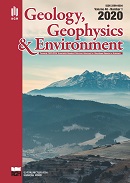Microstructural, mechanical and pozzolanic characteristics of metakaolin-based geopolymer
DOI:
https://doi.org/10.7494/geol.2020.46.1.57Keywords:
metakaolin, geopolymer concrete, compressive strength, flexural strength, reinforced concreteAbstract
The use of cement contributes to global CO2 emission and this leads to the depletion of ozone layer,causing global warming. The quest to reduce or eliminate this problem has resulted in the discovery of metakaolin-
based geopolymer as an alternative to the use of cement in construction work. In this study, metakaolin obtained
as a result of kaolin calcination from some deposits in Nigeria; Ogun (Imeko), Edo (Okpela), Ondo (Ifon)
and Ekiti (Isan-Ekiti) were characterized and used to determine the compressive and flexural strength of metakaolin-
based geopolymer concrete (Mk-GPC). Cubes of 150 × 150 × 150 mm were used for the compressive strength
test and reinforced concrete beams of size 150 × 250 × 2160 mm were produced to test for flexural strength. A water-
absorption test was also carried out on Mk-GPC and the effect of ball-milling was assessed on the strength
properties. The results from the various tests showed that 800°C for 1 hour of calcination of kaolin gives best
combination of performance properties due to the presence of amorphous silica in metakaolin. Mk-GPC gave
higher compressive strength and at an early age than ordinary Portland cement (OPC) concrete. The water absorption
capacities of Mk-GPC were higher than the control samples. In the flexural strength test, the reinforced
beams failed in flexural-shear mode and the shear capacities at 28-, 56- and 90-day curing age of the beams were
between 0.656 and 0.938 MPa for Mk-GPC beams and between 0.563 and 0.844 MPa for the control beams. The
moment capacities for the beams were between 19.25 and 33.25 (×10³ kgm²/s²) for Mk-GPC beams and were between
22.75 and 28.0 (×10³ kgm²/s²) for the control beams. The study has revealed that metakaolin-based geopolymer
can serve as an alternative to cement for sustainable construction in the Nigerian construction industry.
Downloads
References
Abiodun Y.O., Sadiq O.M., Adeosun S.O. & Oyekan G.L., 2019. Mineralogical properties of kaolin and metakaolin from selected areas in Nigeria and its application to concrete production. West Indian Journal of Engineering, 42(1), 57–64.
Aboulayt A., Riahi M., Ouazzani Touhami M., Hannache H., Gomina M. & Moussa R., 2017. Properties of metakaolin based geopolymer incorporating calcium carbonate. Advanced Powder Technology, 28(9), 2393–2401.
Alonso S. & Palomo A., 2001. Alkaline activation of metakaolin and calcium hydroxide mixtures: Influence of temperature, activator concentration, and solids ratio. Materials Letters, 47(1–2), 55–62.
Ambroise J., Maximilien S. & Pera J., 1994. Properties of metakaolin blended cements. Advanced Cement Based Materials, 1, 4, 161–168, https://doi.org/10.1016/1065-7355(94)90007-8.
Andrew R.M., 2017. Global CO2 emissions from cement production. Earth System Science Data Discussions, August, 1–52.
ASTM C618, 1992. Specification for Chemical Composition of Pozzolans. ASTM International.
ASTM C78, 2016. Standard Test Method for Flexural Strength of Concrete (Using Simple Beam with Third-Point Loading). ASTM International.
Arthur H.N., David D. & Charles W.D., 2010. Design of Concrete Structures. 14th ed. McGraw-Hill, New York.
Boden T.A., Andres R.J. & Marland G., 2016. Global, Regional, and National Fossil-Fuel CO2 Emissions. Carbon 25 Dioxide Information Analysis Center, Oak Ridge National Laboratory, U.S. Department of Energy, Oak Ridge, Tenn., U.S.A.
Brooks J.J., Johari M.A.M. & Mazloom M., 2000. Effect of admixtures on the setting times of high-strength concrete. Cement and Concrete Composites, 22(1), 293–301.
BS 1881-122, 1983. Testing Fresh Concrete: Method for Determination of Water Absorption. British Standards Institution.
Cao D., Su D., Lu B. & Yang Y., 2005. Synthesis and structure characterization of geopolymeric material based on metakaolinite and phosphoric acid. Journal Chinese Ceramic Society, 33, 1385–1389.
Davidovits J., 2013. Geopolymer Cement a Review. Geopolymer Science and Technics, Technical Paper, 21, Geopolymer Institute Library.
Foraminifera Market Research, 2016. Kaolin Deposits and Mining in Nigeria. The Opportunities, https://foramfera.com/2016/03/02/kaolin-deposits-and-mining-in-nigeria-the-opportunities/ [access: 2.03.2017].
Jian-Tong D., 2002. Effects of metakaolin and silica fume on properties of Concrete. ACI Material Journal, 13(6), 19–28.
Marita L.B., Jay G.S., Kwesi S.C. & Craig H., 2013. Overcoming barriers to implementation of geopolymer concrete. [in:] Concrete 2013: conference proceedings. Understanding concrete, Concrete Institute of Australia.
North M.R. & Swaddle T.W., 2000. Kinetics of silicate exchange in alkaline aluminosilicates solutions. Inorganic Chemistry, 39, 2661–2665.
Perera D.S., Hanna J.V., Davis J., Blackford M.G., Latella B.A., Sasaki Y. & Vance E.R., 2008. Relative strengths of phosphoric acid-reacted and alkali-reacted metakaolin materials. Journal of Materials Science, 43, 6562–6566.
Rangan V.B., 2010. Fly Ash-Based Geopolymer Concrete. [in:] Proceedings of the International Workshop on Geopolymer Cement and Concrete, Allied Publishers Private Limited, Mumbai, India, 68–106.
Rashad A.M., 2015. Metakaolin: Fresh properties and optimum content for mechanical strength in traditional cementitious materials – A comprehensive overview. Reviews on Advanced Materials Science, 40(1), 15–44.
Tchakouté H.K. & Rüscher C., 2017. Mechanical and microstructural properties of metakaolin-based geopolymer cements from sodium waterglass and phosphoric acid solution as hardeners: A comparative study. Applied Clay Science, 140, 81–87.
Xiao Y., 2009. Geopolymerization process of alkali-metakaolinite characterized by isothermal calorimetry. Thermochimica Acta, 493, 49–54.
Downloads
Published
Issue
Section
License
Authors have full copyright and property rights to their work. Their copyrights to store the work, duplicate it in printing (as well as in the form of a digital CD recording), to make it available in the digital form, on the Internet and putting into circulation multiplied copies of the work worldwide are unlimited.
The content of the journal is freely available according to the Creative Commons License Attribution 4.0 International (CC BY 4.0)










